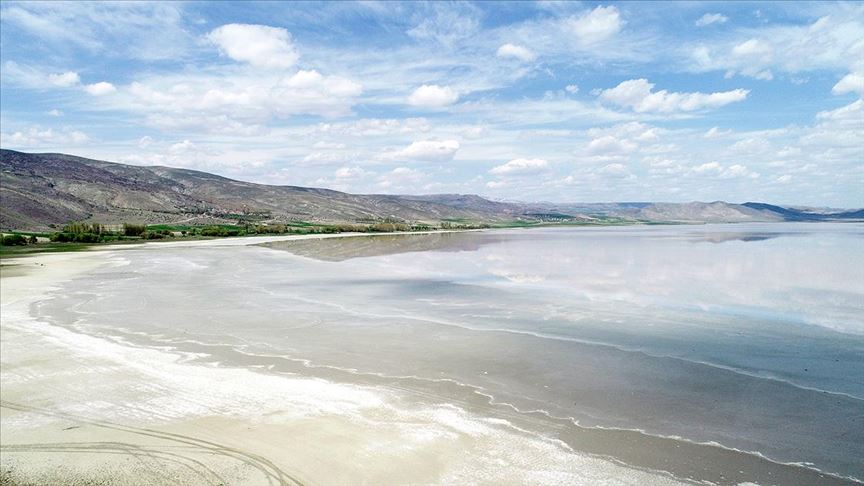Tuzla (Palas) Lake, located 40 km northeast of Kayseri province and having a surface area of approximately 25-35 km², is one of the only salt lakes in Central Anatolia that is relatively pristine and has largely preserved its natural characteristics. The lake, which is part of the Palas Plain, is an important representative of the Anatolian steppe ecosystem and a special geological-geomorphological structure.

Tuzla Lake (Anadolu Ajansı)
Geology and Geomorphology
Tuzla Lake and its surroundings host geologically very diverse rock groups. While Quaternary-aged alluviums are located in and around the lake, Tertiary-aged formations spread over large areas are found in the east of the basin, and Mesozoic-aged formations are seen in a relatively narrow area in the southwest. The Mesozoic formations include deep-sea origin rocks such as ophiolite-peridotite, along with crystallized limestone units, and present a structure fragmented by faults. Various claystone, sandstone, and conglomerate (çakıltaşı) units from the Oligocene, Miocene, and Pliocene periods make up the grounds that form the sedimentary fill of the plain and are rich in groundwater. Furthermore, volcanic hills arranged linearly are seen in and around the Palas Plain; these volcanics formed along the fault lines in the region.
The Palas Plain exhibits a typical playa (arid region lake) basin structure with its wide flatness and low slope values. It is bordered by hills such as Ardıçlı, Sivri, Topak, and Ağkaya starting 500 meters from the lake to the west, by Bekçi Tepe to the south, and by elevations from Sultanhanı to Çeksorut Mountain to the east. The plain and lake belt is characterized by the spreading of lake water over large areas, especially during rainy periods, thanks to the low gradient.
Climate
Tuzla Lake and its surroundings are located in a geography where steppe climate characteristics are dominant. The region, defined as "hot steppe" (BSh) in the Köppen climate classification, is defined as semi-arid according to the De Martonne and Thorthwaite classifications, arid according to Erinç and Aydeniz, and a medium continental climate type (continentality index 31.63) according to the Conrad formula. Hot and dry summers, along with cold and snowy winters, show that the amount of precipitation is low and irregular.
Hydrography
The lake is naturally replenished by streams feeding from the north and south and by groundwater. Değirmen Stream from the east, Yertaşpınar from the southeast, and Körpınar, Başpınar, and Soğukpınar from the south constitute the lake's main surface water sources. The periodic floodwaters of the wet meadow areas to its east are also effective in feeding the lake. In the summer months, the decrease in precipitation and increase in evaporation lead to the shrinking of the lake area and the formation of salt layers 10-15 cm thick on its edges.
Ecosystem and Biological Diversity
Tuzla Lake attracts attention with the diversity of habitats it hosts. Although aquatic life in the lake is limited due to high salinity, the wet meadows, salt steppes (tuzcul bozkırlar), reed beds, pasture, and agricultural lands around the lake constitute important habitats, especially for birds, some amphibian, and reptile species.
In terms of avifauna, the lake is at the intersection of migration routes connecting the African, Asian, and European continents. Species included in the Red List of Birds of Turkey and the IUCN Red List, such as the great bustard (Otis tarda), greater sand plover (Charadrius leschenaultii), Kentish plover (Charadrius alexandrinus), ruddy shelduck (Tadorna ferruginea), spur-winged lapwing (Hoplopterus spinosus), and lesser kestrel (Falco naumanni), are seen or breed in the region. Additionally, birds such as the common crane (Grus grus) and the red-backed shrike, along with plovers (cılıbıtlar), also use this area during migration.
The vegetation consists of salt steppe and wet meadow habitats, represented mainly by halophytic (tuzcul) herbaceous plants from the Chenopodiaceae family and woody plants from the Tamarix species. In the region's flora, 294 species belonging to 51 families have been identified, and 22 of them have been determined to be endemic. The Işıl tulip (Tulipa armena Boiss. var. lyrica), specific to the region, and Elymus elongatus (Host) Runemark, which lives only here and in Sultansazlığı in the world, show the importance of the lake in terms of plant diversity.
The mammal fauna includes species such as the marbled polecat (Vormela peregusna), Williams's jerboa (Allactaga williamsi), Anatolian ground squirrel (Spermophilus xanthoprymnus), fox (Vulpes vulpes), and wolf (Canis lupus).
Historical and Cultural Characteristics
Tuzla Lake and its surroundings bear the traces of many civilizations throughout its history. It has witnessed settlement in various periods from the Hittites to the Ottomans since the 2nd millennium B.C. and has been at the intersection of important migration and trade routes. The hans (inns), caravanserais, mosques, and tombs (türbeler) that have survived to the present day around the lake reflect the historical and cultural richness of the region.
Touristic Potential
Its proximity to the Kayseri provincial center and the presence of recreational areas (mesire alanları) such as the Pınarbaşı location, Kayabaşı, Kayaaltı, and Sarımsaklı Valley offer significant potential for day-trip tourism. Furthermore, the region allows for nature tourism with bird watching, nature hikes, nature photography, and mud bath areas west of the lake. The coexistence of various historical and natural assets makes the region attractive for visitors.

Tuzla Lake Aerial View (Anadolu Ajansı)
Protection Status
For Tuzla Lake, protection zones were determined under the Regulation on the Protection of Wetlands on June 13, 2007, and it was subsequently declared a 1st-degree natural protected area (doğal sit alanı) on June 26, 2009. It has been under protection since 1993 and is counted among Turkey's new Ramsar sites. These statuses are of a nature that registers the lake's importance in terms of natural and biological values at national and international levels.


